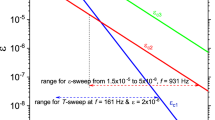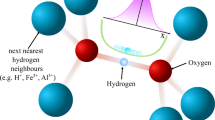Abstract
Hydrogen atoms dissolve in Pd at densities up to one H atom per Pd, which provides higher atomic H density than in solid H2. They are known to have large diffusion coefficient due to quantum tunneling. Torsional oscillator (TO) technique is employed to investigate the phases of H in Pd, which is known to show phase boundaries at the lowest T among metal-hydrogen (MH) systems. Specific heat measurements have been performed for PdH x with x up to high H concentration specimens as well as studies of the resistivity study to establish the unique x−T phase diagram. We have, in addition, been performing TO experiments, in order to study the effect of atomic H intrusion and the dynamics in the PdH(D) x system. The TO is a well-established, powerful instrument method to investigate superfluidity and quantum vortices of liquid He, especially in thin films, as well as dislocation dynamics in solids. In our TO experiments on PdH x specimens have shown a resonance frequency shift for PdH x , with 0.16≤x≤0.75 at the lowest T’s, which can be largely explained by the lattice deformation by H intrusion. This x dependent contribution has a smaller, additional change depending on x and T above ∼50 K. We will show the details of experimental data and discuss the correspondence to the phonon modes change and further possibility of studying occurrence of quantum phenomena for the hydrogen system.
Similar content being viewed by others
References
Y. Fukai, The Metal-Hydrogen System (Springer, Berlin, 2005)
A.I. Kolesnikov, I. Natkaniec, V.E. Antonov, I.T. Belash, V.K. Fedotov, J. Krawczyk, J. Mayer, E.G. Ponyatovsky, Physica B 174, 257–261 (1991)
Y. Fukai, H. Sugimoto, Adv. Phys. 34, 263–326 (1985)
D.A. Papaconstantopoulos, B.M. Klein, E.N. Economou, L.L. Boyer, Phys. Rev. B 17, 141–150 (1978)
G.J. Zimmermann, J. Less-Common Met. 49, 49–66 (1976)
J.K. Jacobs, C.R. Brown, V.S. Pavlov, F.D. Manchester, J. Phys. 6, 2216–2232 (1976)
B. Kappesser, U. Stuhr, H. Wipf, J. Weissmuller, C. Klos, H. Gleiter, J. Alloys Compd. 231, 337–342 (1995)
K. Yamakawa, J. Alloys Compd. 393, 70–76 (2005)
H. Akaki, Y. Sakamaki, S. Harada, M. Kubota, J. Alloys Compd. 446–447, 436–438 (2007)
H. Araki, S. Harada, M. Kubota, J. Phys. Chem. Solids 66, 1490–1492 (2005)
H. Araki, S. Harada, M. Nakamura, S. Harada, T. Obata, N. Mikhin, V. Syvokon, M. Kubota, J. Low Temp. Phys. 134, 1145–1151 (2004)
D.M. Nace, G.J. Aston, J. Am. Chem. Soc. 79, 3627 (1957)
O. Blaschko, J. Less-Common Met. 100, 307–320 (1984)
M. Kubota, et al. J. Low Temp. Phys. 158, 572–577 (2010). arXiv:0903.1326
J.G. Bednorz, K.A. Muller, Z. Phys. B 64, 189–193 (1986)
A. Leggett, Quantum Liquids (Oxford Univ. Press, London, 2006)
J.M. Kosterlitz, D.J. Thouless, J. Phys. C 6, 1181–1203 (1973)
D.J. Bishop, J.D. Reppy, J. Phys. C 6, 339–341 (1978)
D.S. Fisher, M.P.A. Fisher Huse, Phys. Rev. B 43, 130–159 (1991)
Y. Kamihara et al., J. Am. Chem. Soc. 128, 10012–10013 (2006)
T.E. Ellis, C.B. Satterthewaite, M.H. Mueller, T.O. Brun, Phys. Rev. Lett. 42, 456–458 (1979)
J.E. Schirber, B. Morosin, Phys. Rev. B 12, 17–118 (1975)
S. Harada, T. Kasahara, S. Tamaki, J. Phys. Soc. Jpn. 54, 168–174 (1985)
H. Hemmes, B.M. Geerken, R. Griessen, J. Phys. F 14, 2923–2933 (1984)
Author information
Authors and Affiliations
Corresponding author
Rights and permissions
About this article
Cite this article
Harada, S., Donuma, T., Araki, H. et al. Low T Study of PdH x System by Torsional Oscillator Technique: x Dependent Responses. J Low Temp Phys 162, 724–732 (2011). https://doi.org/10.1007/s10909-010-0327-8
Received:
Accepted:
Published:
Issue Date:
DOI: https://doi.org/10.1007/s10909-010-0327-8




